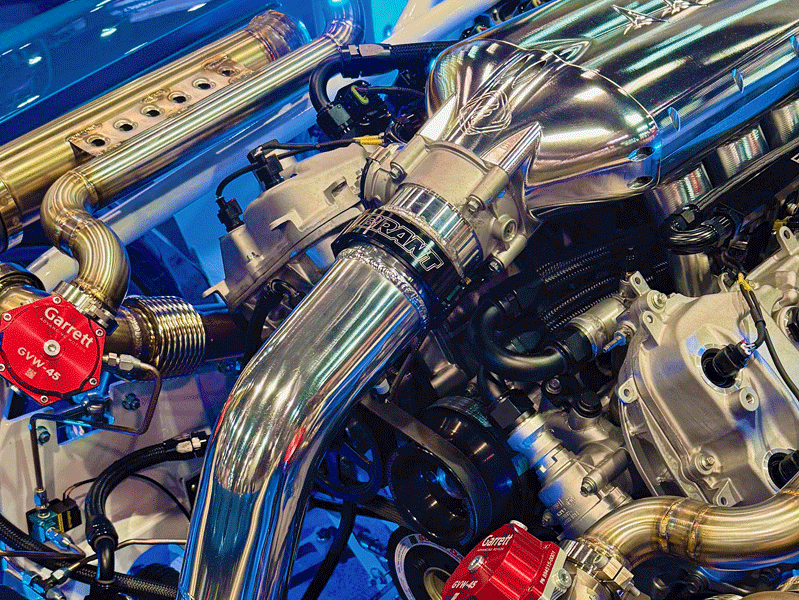Special Report: Follow the Science

Outside of the limelight typically reserved for high-profile teams and drivers, medical professionals are quietly using breakthrough discoveries in human biology to help facilitate sharper—and safer—performance behind the wheel.
Scientific and medical advances that relate to motorsports can sometimes break through with revolutionary suddenness, but usually the process moves forward at a steady, evolutionary pace. Undertaking research to find new ways to keep drivers and crew safer, and improving driver performance, is a marathon, not a sprint, as the saying goes.
Rest assured, behind-the-scenes research is ongoing, the equipment is improving, and the knowledge base is deepening. Much of that progress comes from the manufacturers of safety equipment themselves. “They don’t rest on their laurels. They’re always saying, ‘How can we make our products better?’” said Tom Weisenbach of the International Council of Motorsport Sciences (ICMS), Indianapolis, Indiana.
“I think we have definitely improved the PPE [personal protective equipment] the motorcycle riders and drivers are utilizing to protect them, whether it’s fire, whether it’s impact collision, what have you, we’ve seen improvements,” he said. “I give credit for that to the PPE manufacturers, to SFI, Snell, and the FIA. Those organizations are setting the standards that are now required and the specs on safety products.”
Beyond the established brand names and organizations most racers would recognize, there is a substantial amount of work quietly being done by medical professionals that is leading to better outcomes for racers. Many of the high-profile medical studies in racing have traditionally revolved around patching drivers back together after crashes, but in speaking with sources for this story, we found a number of talented professionals diving deep into the basics of nutrition, sleep, and bio-mechanics, and how they relate to motorsports participants.
“Nutrition is a big thing now,” Weisenbach said. “I don’t care what type of racing you’re in, you’re seeing more and more of an emphasis put on the racer for nutrition and making sure they’re eating properly. And then also getting enough sleep. That’s something that I don’t know people years ago even thought about. I still don’t know how some of our sanctioning bodies, which run 100-plus races a year, how their crew members and racers get enough sleep. But I know if you look at Formula 1 teams, the majority of them have their own team nutritionist who works with not just the drivers but the crew members as well to make sure they’re eating properly.”
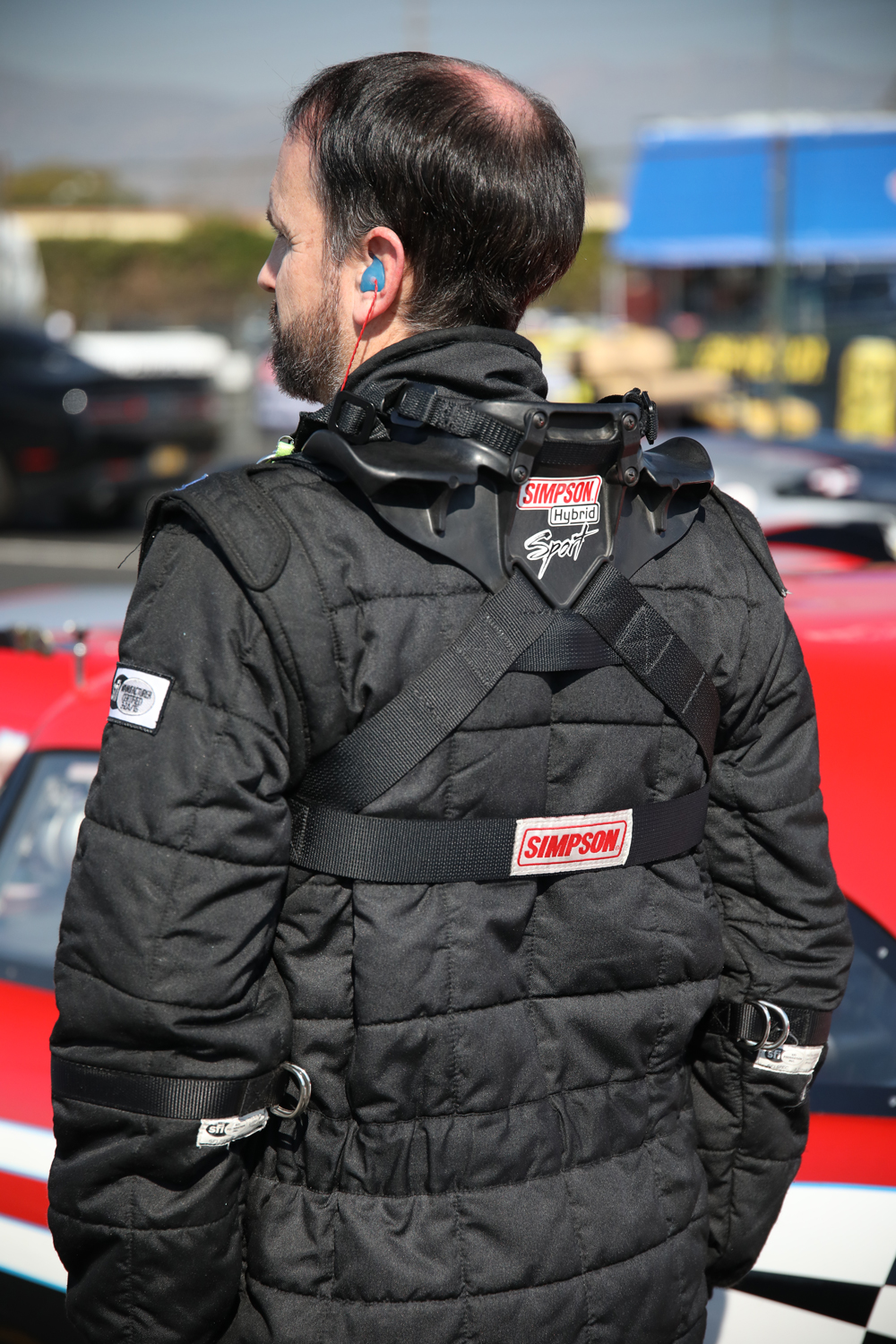
Talk to the Doc
The casual observer might be surprised to learn how much of motorsports-related medical research is focused on fundamental aspects of human biology. At a superficial glance, some of these studies seem to concern themselves with what many would consider common-sense knowledge. Most people are at least vaguely aware of the importance of hydration, nutrition, and sleep. But the question becomes, how much sleep? What’s the proper level of hydration for a driver or crew? How can proper nutrition improve driver performance? As it turns out, specific answers to these questions and how they affect racers haven’t really been studied much until recently.
Now that they are being studied, some amazing data is coming out. David P. Ferguson is an assistant professor of kinesiology at Michigan State University in East Lansing, Michigan, where one area of his studies examines physiological stresses placed on race car drivers and pit crews. “I’m an exercise physiologist. Think of me as a mechanical engineer for the human body,” he said. “I spend my time looking at stressors that fatigue drivers. That could be something like heat, dehydration, G-forces, vibration, anything like that. And then I use physical training, nutrition, and then even a little bit of engineering to make them fatigue less in the car. Which, of course, improves safety because they don’t have as many crashes. And on the flip side, it makes them faster, which they like.”
Ferguson has witnessed a major shift in attitudes since he began his studies. “When I started this, race car drivers were not even considered athletes. They just thought they sat there and drove their car around the race track and nothing much happened,” he said. “In fact, when I first started doing these studies and publishing some of the initial results, manuscripts would be rejected at sports journals because they would say, ‘Race car drivers are not athletes, so we can’t accept your paper.’
“We now know that they are considered athletes,” he continued. “Their cardio-respiratory fitness is pretty much equal to an elite triathlete. They’re quite fit. When they compete, they will drive the race car for two to four hours at a heart rate of 160 to 180 beats per minute. They’re going to burn 2,000 calories in the race. They’re going to lose about 7 pounds of sweat, due to the fact they’re in the hot cockpit and sweating quite a lot. The G-forces they’re going to experience are quite massive—actually, every race car driver would qualify for the Apollo space program for the amount of G-forces they can handle. They’re quite exceptional athletes.”
A big part of being able to maintain that level of performance is tied to getting enough quality sleep, and the sleep habits of athletes is another area that is receiving fresh scrutiny. Dr. Meeta Singh specializes in sleep science and has given talks at the ICMS Congress on the effects of sleep on mental health.
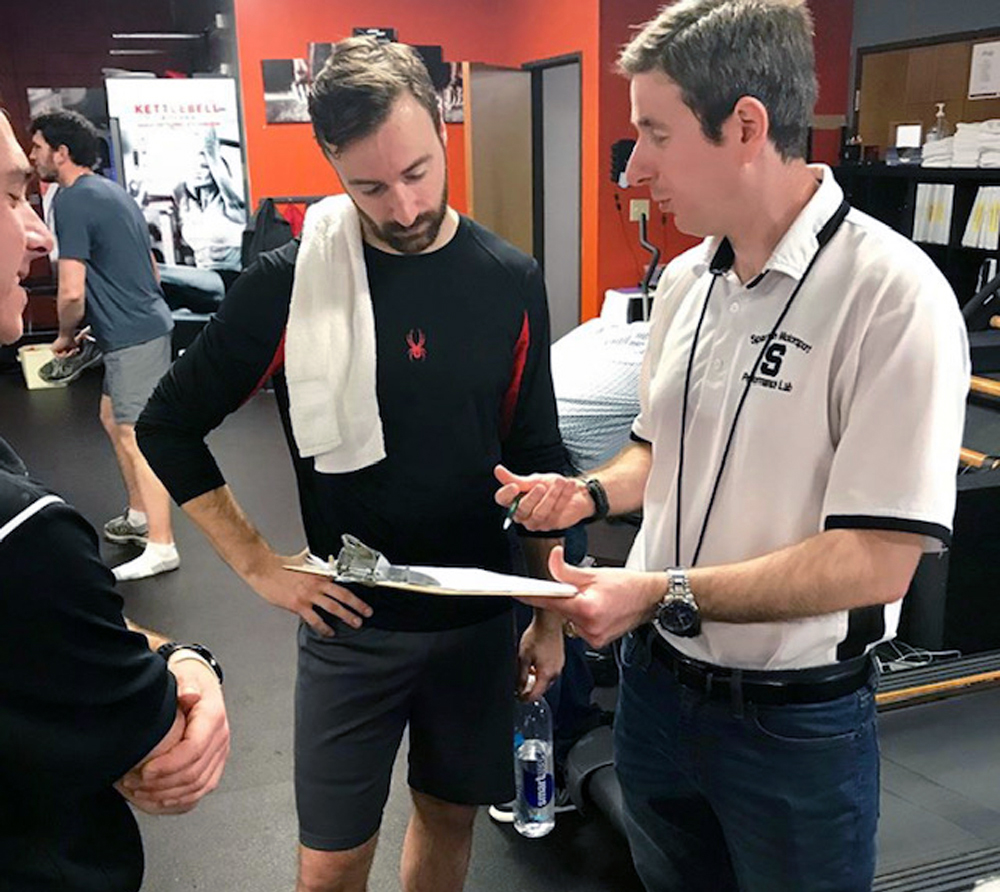
“I’m a sleep doctor and a psychiatrist. My expertise and experience is working with professional athletes. And I firmly think that drivers, they’re athletes,” she said. “When it comes to athletes of any kind, whether they’re motorsports drivers or playing football, in any of the major leagues, the lifestyle of a motorsports driver, as well as the pit crew, is tough. Their schedule, their practice times, the way that they’re together with their travel, the week leading up to the actual weekend of races, all of those factors make it difficult to fit sleep into their lives.”
Constantly crossing time zones while living out of a suitcase can result in problems with sleep and problems with circadian rhythm disorder, she said. “The problem is that number one, being in this sport is problematic for sleep, but then it’s the vice-versa that also holds true. Having impaired sleep, having irregular sleep or chronically being deprived of sleep itself can result in impaired reaction times. It can make you less accurate. Your judgment is impaired, so you are likely to put yourself in risk-taking situations. That may be okay for you and me, but imagine if you’re in a car that’s going 150 mph. Then those small, split-second decisions can mean the difference between winning or crashing.”
Anyone who has pulled a race car onto a track knows that the track condition, vehicle setup, and constant G-forces from acceleration and negotiating turns result in constant head motion. But exactly how much head motion does the typical driver endure? That too is being studied. Dr. Joel Stitzel Jr. is a professor and chair of biomedical engineering at Wake Forest University in Winston-Salem, North Carolina. “My training started in vehicle safety, understanding how passenger vehicles are regulated and the bio-mechanics of crash-test dummies,” he said. Stitzel is a past president of the Association for the Advancement of Automotive Medicine (AAAM).
“We’ve started to study more and more the environment of the vehicle as it relates to what we call environmental loads or accelerations or motions of the head. And also crash-related biomechanics of the head,” he said. “We developed instrumentation to study head motions in sports. With NASCAR’s support, we started looking at deploying this sensor system, instrumentation system, out in some NASCAR vehicles and different testing environments.
“Toyota took an interest in what we were doing, and then Toyota Racing Development has supported us to help understand the grassroots dirt track environment with this instrumentation system.
“In a nutshell, what we’re learning about is what the head is experiencing when you’re driving around the track on pavement or on dirt, and we’re starting to look into characterizing that environment and then what sort of things you might think about down the road to improve the situation for the drivers,” added Stitzel.
Gathering Data
The key to turning research into products and policies that benefit the driver is being able to gather data, and in that field, technology has made significant advances. “Sports analytics, data analytics are becoming a big thing in all other sports,” Ferguson said. “Special sensors can be put on a bat, a football, or on a player and watch them do all sorts of stuff. But, for the first time, racing is actually leading the field. These cars collect so much data and there are so many sensors, that they’re already set up to collect data on various drivers. You go to an engineer and say, ‘I want to measure this,’ and they’ve probably got a sensor for it. We have ear accelerometers in the earpieces now. In my work, for the longest time we had a bio-harness that the drivers wore. It was like a chest-piece that could measure their heartrate with an EKG, and from that we could get skin temperature and breathing rate. We would have them swallow a little pill, like a multi-vitamin, and it transmitted their core body temperatures. We could see how hot they’re getting. We did that for a long time. We are actually moving away from that and going to an ear temperature sensor to measure core body temperature, just like when you go to the doctor and they take your temperature with your ear, it’s the same thing.
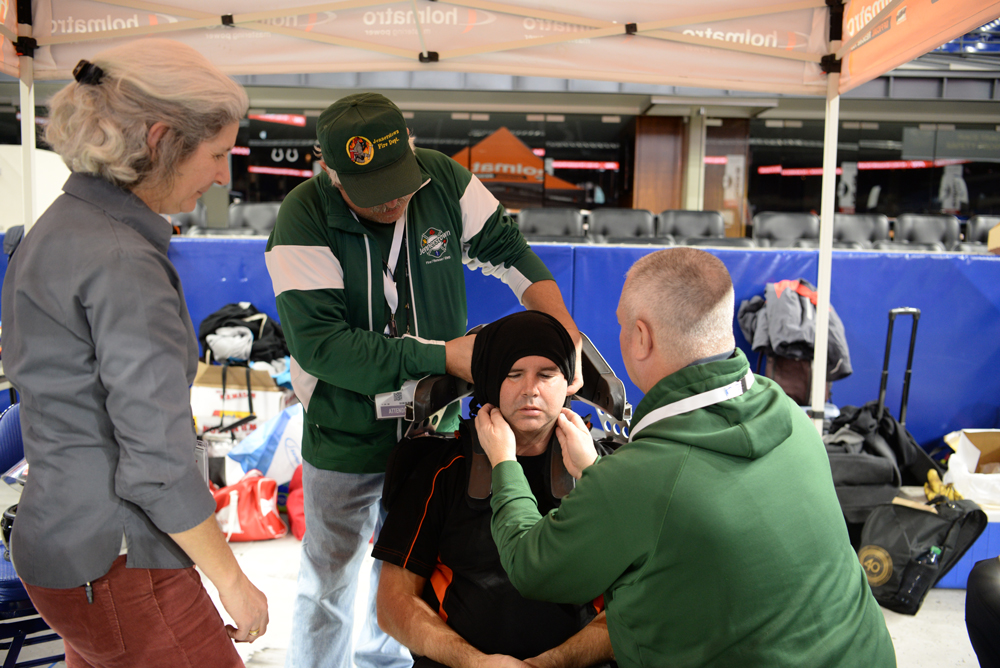
“A lot of drivers complain about how hot it is in the new NASCAR car and the new IndyCar with the windscreen,” Ferguson continued. “So we’re really trying to push getting a temperature sensor in the earpiece. You take all that data and feed it into the car’s data system and then you have everything. You’ve got car and driver as one. You have heart rate and oil temperature. It’s pretty cool to look at.
“From where I started to where I am now, it’s pretty wild. I still remember lugging a big box of batteries and wires and all this stuff, and now we’re on the micro-level. It’s come a long way in 15 or 20 years,” Ferguson concluded.
One of the data recording devices Stitzel has been utilizing in his studies is a mouthpiece that incorporates sensors. “It goes into the roof of the mouth and it’s not visible. It’s not a mouth guard, so no one can see it. It’s one of the systems that drivers are generally comfortable to wear,” he said. “We’re learning what those environments are like at a really detailed level for the head, in a way that we could use that information to design seating, design maybe a head-and-neck restraint, maybe a helmet, to improve the situation.
“Think of this like an instrumented data recorder for the head,” Stitzel continued. “The instrumentation system fits within acrylic. It’s almost like a retainer, a similar design that goes behind the teeth. On that system is a linear accelerometer, angular rate sensor, the stuff needed to store, the stuff needed to power, and later on we connect this to Bluetooth and download the information.”
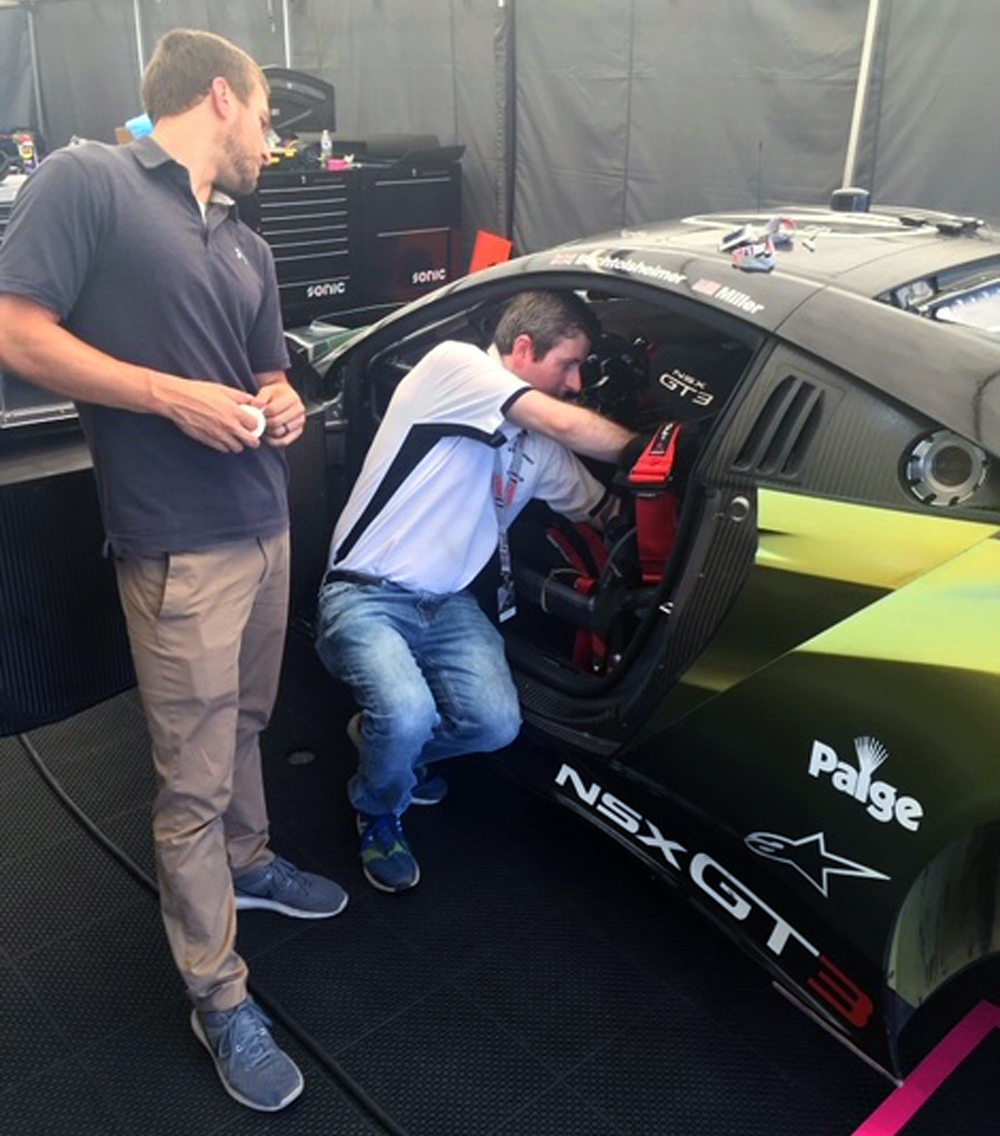
Commercially available health tracking systems have also opened doors in ways that can help motorsports participants. “Typically, I focus on screening the athletes for any sleep disorders and then helping them with their sleep issues throughout the season,” said Singh. “There is lots of new technology that can help. Now we have these handheld wearables, devices that can be worn on the wrist or on a ring that can help measure sleep. Just wearing these will not make sleep better, but now we can collect data about people’s sleep without them having to do something. Once we get that data, we can have actionable items from that data we can do.”
Track Results
How is all that research and data gathering improving driver performance and safety? Concrete examples of how a better understanding of human biology can affect driver performance are making their way to the track.
“What’s really kind of cool is what we’re learning now, about how important hydration is in race car driver physiology,” Ferguson said. “We just completed a study that showed if a driver becomes dehydrated, they lose the ability to modulate, and the car kind of goes into a point of understeer. They’re kind of sliding a little bit over the corner, which makes it slower, tears the tires up. They could drop a wheel and possibly spin off the track. But if they stay hydrated, and drink throughout the race session, that doesn’t happen so they can optimize their performance. Our data suggest that will save a driver basically one second a lap on a road course, which is pretty exciting.”
Applying those findings in an across-the-board way has always been a challenge, but there is progress on that front. “We’re starting to see a lot of the manufacturers homologate drink systems in cars,” Ferguson said. “We actually dictated how much fluid you should drink in the car. A lot of teams are going to say, ‘We’re not going to put a drink system in the car, that’s added weight.’ So what manufacturers are doing now is homologating it. ‘You buy this car, it’s got this drink system in it. Every car has this drink system in it. You don’t have to worry about the weight now.’ So now teams are saying, ‘Okay, the driver can drink now.’”
Staying hydrated during a race yields results, but eating well is just as important. “The biggest thing that was illuminating to us was how many calories these drivers actually burn,” Ferguson said. “In a two-hour race they’re going to burn 2,000 calories. That’s what most Americans burn in a 24-hour period. Then you have to figure out how to refuel that. What’s interesting, we have the equipment to not only measure the calories someone is burning, but also if they’re burning carbohydrates, fats, or proteins. When a driver is in a high-G corner or really battling it out to push the car, they’re going to burn more carbohydrates because carbohydrates are more easily broken down and used by your body. But if they’re on a fuel-save lap or running a triple stint in the middle of the night at Le Mans or something like that, they’re going to burn a lot of fat.
“With that information you can make meals for drivers—a pre-race meal, a post-race meal, you can tell them how many calories they need to include, what it should be made of, how much carb, fat, protein,” Ferguson continued. “Let’s take the endurance races like Daytona, Le Mans. You can actually have in-between-stint meals. ‘Okay, during this stint we know what you’re going to burn, so eat this, that’ll get you ready to go back in the car four hours from now.’”
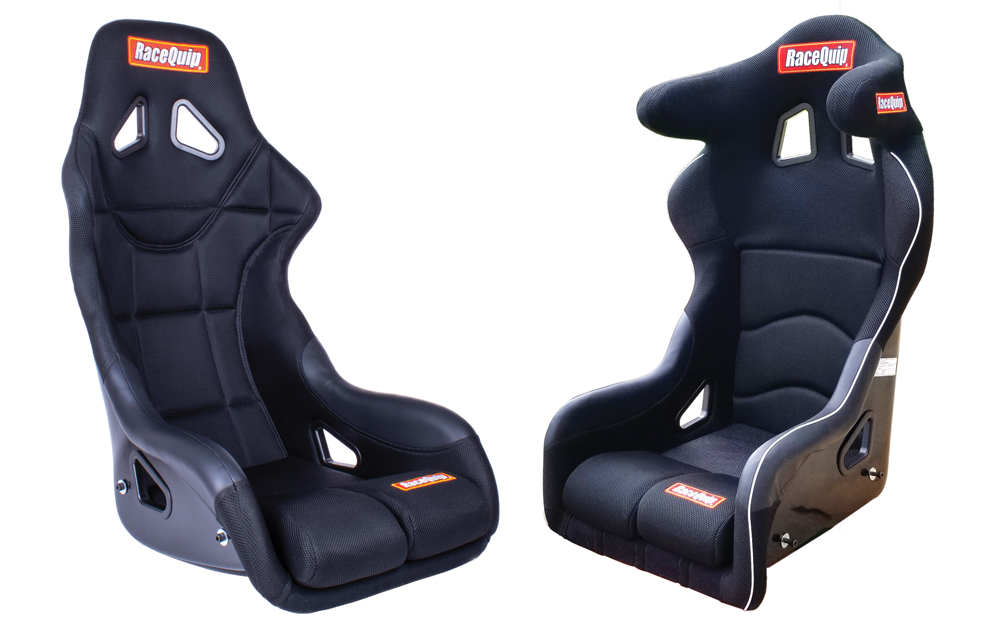
The extreme calorie burning that racers routinely undergo produces some unexpected side effects that need to be understood. “Talk about nutrition also addresses percent body fat,” Ferguson said. “Take any Olympic athlete, run their metrics, and they’re around 3% body fat. Race car drivers seem to be in the 12–16% body fat range. These are people who have won multiple championships, legends of the sport. They always say to me, ‘Shouldn’t this be lower? I train really hard. Shouldn’t my percent body fat be lower?’ What we’re finding out is that due to the high caloric expenditure in the car, and the big travel days that they do, these athletes actually need to store that fat to have the fuel to do what they do. It’s kind of a unique thing in terms of nutrition in sport, of knowing how much fuel someone needs. They also need a certain level of body fat just to sustain performance. When we see drivers with less than that they get sick quite a lot, they fatigue a lot, and they really don’t advance in the sport. It’s kind of a unique thing in terms of sports nutrition.”
Walking hand-in-hand with nutrition is the importance of sleep, and here small changes can provide big performance dividends. “When it comes to what sort of advice one should give, I think that even looking at really simple things can get a big bang for the buck,” Singh said. “One of them is caffeine, being aware of how much caffeine you’re drinking.
“Number two is being aware of how much alcohol you’re drinking. Number three is this thing about light exposure. Many times, drivers go into a new hotel room and feel they have to unwind. They may be on their laptop, they may be playing video games, they may be on the Internet scrolling social media. That will all impair their sleep. You want to keep the room cold, it should be dark, it should be comfortable. Those are some common, simple things you can tell athletes. But athletes are individuals, so some people just have difficulty sleeping when they’re in strange environments. If you’re one of those people, then any time you travel and stay in a hotel room you’re going to have difficulty falling asleep. That may take more intensive one-on-one work, taking their history and finding out how we can help them,” she said.
“The reason we talk about light exposure at night and how it impairs sleep is because our brains actually need darkness to get the signal that we’re ready to sleep,” Singh added. “Light is like an alertness signal at the wrong time if you get exposed to bright light at night. When it comes to light, we talk about lux. So the higher the lux, the brighter the light, the worse it is. The blue-green wavelength is worse as compared to red light. The longer you expose yourself to bright light at night, the worse your sleep is going to be. Because of that, there are some studies that show if you wear blue light blocking glasses, that might actually help you fall asleep because you’re preventing your exposure to blue light, which makes it difficult to sleep.”
Stitzel’s research into driver head motion could very well lead to new equipment and practices on the track. “It’s not hard to make the leap that it has implications maybe for fatigue of neck muscles,” he said. “How do you feel after driving for an hour or two? That has an effect. We really don’t know the amount of vibration that you can handle. When you’re driving a NASCAR Cup series vehicle, or a grassroots dirt midget car, there’s a lot of vibration in that environment. You’re shaking a ton. And we’re starting to measure all that. Depending on what threshold you use, you’re talking like two to three, to eight to 10 times per second that your head is moving back and forth. We’re starting to look at that at a really detailed level. We don’t know what the threshold is. We don’t know how much is too much, how many times is too many times, so we operate under this principle of public health science. It’s called ‘Precautionary Principle.’ Even though you don’t know what the threshold is, and what you would call ‘okay’ versus ‘not okay,’ it’s still a good idea to reduce it when you sense it’s going on.
“You’d think it would be really easy to go out and get all this data, but it’s a challenge,” Stitzel added. “We’re at the stage now where we’ve done a lot of characterization, and we’ve done a little bit of looking at what is possible with the Cup series cars. But we’re actually just starting to think about that with the grassroots dirt vehicles.”
Gear Up
The racing equipment manufacturers are likewise examining the latest science to make their own inroads into safer gear for the track. “There is evolution taking place on the manufacturers’ side,” said Mike Hurst with the SFI Foundation, an organization that issues and administers quality standards for racing equipment, based in Poway, California. “They are always coming up with new weaves and blends. The biggest changes compared to years ago is how light and comfortable a good driver’s suit can be today. Which then reduces the heat stress—the non-fire heat stress on the driver, which is healthy for the driver. There are hundreds of different models of drivers’ suits that basically meet the same standards, and the difference between a very expensive one, a very nice one, and say an economy suit, is that comfort level and breathability of the fabric. It’s light weight and it’s comfortable to wear. It’s a big difference.”
RaceQuip in Riverview, Florida, manufactures driving suits, gloves, footwear, and other racing safety gear, and it has been able to translate the latest scientific research into readily available products.
“The study of human biomechanics coupled with auto racing crash analysis has led to many advances in everyday safety gear,” said Roger Mealey of RaceQuip. “Understanding what forces your body is subjected to during an impact has caused us to re-think how we build many of our products. Some advances are revolutionary, like a Forward Head Restraint, but most are evolutionary, like adding a containment halo around the top of a seat to limit side movement of the head. Another evolution has been the emergence of 2-inch-wide lap belts instead of traditional 3-inch wide. Testing has taught us that a 2-inch belt will tuck under your hip bone rather than riding on top of it, allowing them to be cinched tighter and load more quickly in the event of an impact.
“Our FIA-rated full containment seats, Snell SA2020 Carbon helmets, and SFI-15 and SFI-20 suits are all examples of new products that were developed using the latest technology in materials and manufacturing techniques,” he said. “The seats and helmets are both lighter and stronger due to advanced composite materials. The seats feature an FRP infused matrix composite covered by an energy absorbing memory foam. The helmets utilize a pre-preg carbon fiber composite material that is then placed into tool steel molds using pressure and heat to cure. Our new SFI-15 and SFI-20 suits use advanced aramid fabrics to provide a very soft and supple multi-layer suit.”
There are plenty of future scientific advances on the horizon for motorsports, but right now, a new emphasis on biomedical fundamentals is yielding fruitful results.
So get a good night’s sleep!
Sources
David P. Ferguson PhD FACSM CEP
Michigan State University
rdsp.canr.msu.edu/faculty/35-ferguson-david
International Council of Motorsport Sciences
icmsmotorsportsafety.org
RaceQuip
racequip.com
SFI Foundation
sfifoundation.com
Meeta Singh MD
meetasinghmd.com
Joel Stitzel PhD
Wake Forest University School of Medicine
school.wakehealth.edu/faculty/s/joel-douglas-stitzel
 MEMBERSHIP LOGIN
MEMBERSHIP LOGIN JOIN PRI
JOIN PRI


